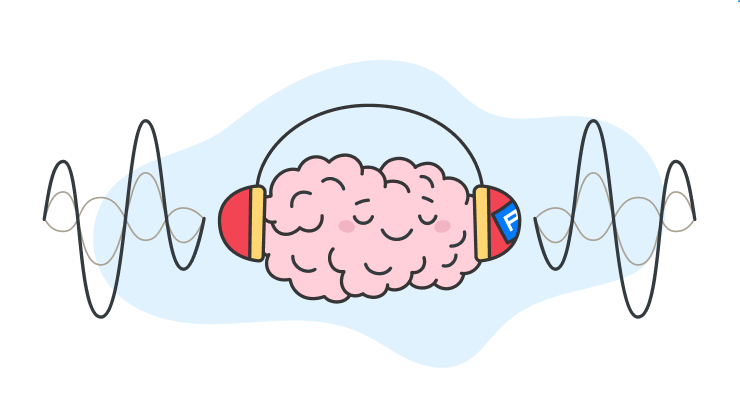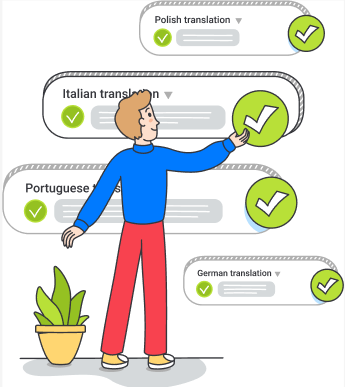작성자 Liza Dziahel
AI Won't Replace Translators, But It Will Transform How They Work
Our blog is for executive teams, marketing, product, localization, and localization teams that actively support international business expansion. We share knowledge gained about localization, globalization, and culturalization to assist you in creating informed global growth strategies. Likewise, we do this by drawing on our two decades of experience running a worldwide localization company. 🌎
Although AI is transforming the translation industry, human translators will still be needed. Rather, it will change the way businesses operate. Artificial intelligence (AI) tools are becoming useful friends, taking care of routine and simple translation jobs so that human translators may concentrate on more intricate and subtle linguistic nuances.
We see 2 big changes in our client’s business environments related to translation:
- The volume of content is rising. There are just not enough human translators to manage the enormous volume of text produced daily.
- Businesses need to move faster. Localization velocity speeds up the time for new goods to reach markets. The fast delivery of multilingual material helps teams from different departments to meet deadlines and achieve their key performance indicators (KPIs).
Machine translation supports both trends.
The applications of machine translation are growing. These days, machine translation is far less restricted to particular business sectors than it used to be:Online shops use MT to customize product lists and consumer reviews. It is used by software and IT companies to translate technical documentation. The gaming industry also widely uses MT to localize in-game material, such as subtitles.
But before drawing hasty judgments about whether technology threatens localization service providers and translators, it is important to remember that innovation has always existed in the language business.
Professionals started proposing using computers and mathematics to speed up language translation in the late 1940s. This signaled the beginning of machine translation's development. Language technology has advanced throughout time, resulting in the creation of increasingly robust and viable machine translation systems.
The neural machine translation (NMT) technique illustrates this ongoing development. Neurons, the interconnected units that form the basis of NMT, are inspired by the structure of the human brain and characterized by mathematical functions. As a result, translation quality has greatly improved, particularly for languages that were previously thought to be too complex for machine translation.

This quick history lesson should teach us that technology and artificial intelligence (AI) are not new ideas that will suddenly endanger our careers. Professionals have embraced each technological advance, learned to adapt, and grown in their careers. But we wonder: will artificial intelligence (AI) ever advance to the point where it completely replaces the need for human translation services?
Our opinion is no. We think that human-technology cooperation—rather than technology's total dominance—is what will determine the future of language services.
For instance, back in 2022, when talking about localization testing, we questioned if businesses could employ AI to automate linguistic testing before a product's launch fully. Anya Zanevskaya, Localization Team Lead at Alconost, offered her thoughts on this:
"It is important to remember that human involvement occurs behind the scenes in all automation; automation does not occur in a vacuum. When it comes to the language components of a project, an attentive native speaker who understands the complete context is still the best-case scenario, even though AI can be trained to spot functional faults and deliver reports. We occasionally use AI-based technology for translation projects, but even in these situations, we constantly consult a native editor to improve the result."

Put another way, when it comes to professional localization testing, people are still involved in the last translation edits made before the product's release. We must remember that the primary objective of the testing is to shield the end user from any contextual mistakes. And who could be more qualified for this job than a linguist knowledgeable about the complexities of their language and culture, including the finer points of meaning?
However, in the context of machine translation post-editing (MTPE), translators may need to modify their workflows and skill sets to cooperate with technology. Transitioning from human translation to post-editing necessitates procedure modifications and specific process tweaks. Let's investigate more closely.
What is the role of translators in cases where clients prioritize cost-efficient solutions like MTPE (Machine Translation Post-Editing)?
For seasoned linguists, machine translation post-editing presents interesting potential for differentiating themselves in the market. The need for professional translators is growing and will not stop as more languages become machine translation-compatible.
It's crucial to understand that post-editing is not the same as translating from scratch. This requires that translators learn a new skill and negotiate a learning curve. Like any other ability, post-editing expertise comes with practice, and one may not achieve maximum output immediately.
To linguists: here are the advantages of learning to post-edit
There are a number of advantages to post-editing that may persuade those who were initially dubious to view it as a valuable talent to add to their resume:
- Starting from scratch will never be necessary because machine translation generates the initial output.
- The output of machine translation might serve as an inspiration for new and imaginative translation concepts.
- Features that improve the adaptability and effectiveness of your workflows are built into machine translation systems, which will ultimately increase production.

Additionally, bear the following in mind if you operate as an editor rather than a translator:
- Start by reading the original text, just like you would with a translation project.
- Reviewing the MT result after you've understood the source material should take some time.
- Leave the MT text alone or make the necessary translations based on the original output.
- Remember to thoroughly review the section after you've made your final edits.
- Be sure to understand how bias occurs in MT and how to combat it.
On top of that, consider the client, the content genre, and the intended audience at every step of the process.

How work will change for translators in the age of AI
The function of translators is changing dramatically in the AI era. Faster turnaround times are made possible by AI-powered translation technologies, freeing translators to concentrate on improving and guaranteeing the accuracy of text generated by machines rather than beginning from scratch. This change quickens the pace of work but also raises the bar for better work and contextual accuracy. The emphasis on post-editing machine translations and specialist language knowledge in payment models is also changing, which may cause a change in compensation schemes. Translators can find themselves working on more intricate and creative projects, using AI to do simple or repetitive translations.

Whether you want your MTPE project to combine human expertise with a dependable machine engine or if you prefer to have human translators translate all of your texts, Alconost can offer you native speakers with relevant industry experience and all the tools you need to achieve your localization objectives. To discuss your project, go to the website or get in touch with the team.
Related articles
인기 글
건강, 피트니스 앱 및 소프트웨어 현지화를 위한 종합 가이드
앱 현지화
10 분 소요 읽기
7배의 전환율 상승 사례로 배우는 마케팅 현지화 전략
영상 제작
보이스오버
9 분 소요 읽기
소프트웨어 현지화를 위해 놓치지 말아야 할 국제화 과정
5 분 소요 읽기
최근 글
9개 국어로 Clue 모바일 앱 현지화 및 업데이트
6 분 소요 읽기
#LocFromHome 요약: 알코노스트의 번역가가 알려주는 글쓰기 팁
5 분 소요 읽기
Bitrix24를 위한 다국어 음성 응답
보이스오버
3 분 소요 읽기
의뢰하고 싶은 프로젝트가 있으신가요?
자세한 내용을 말씀해 주시면 솔루션과 견적 금액을 안내해 드리겠습니다.